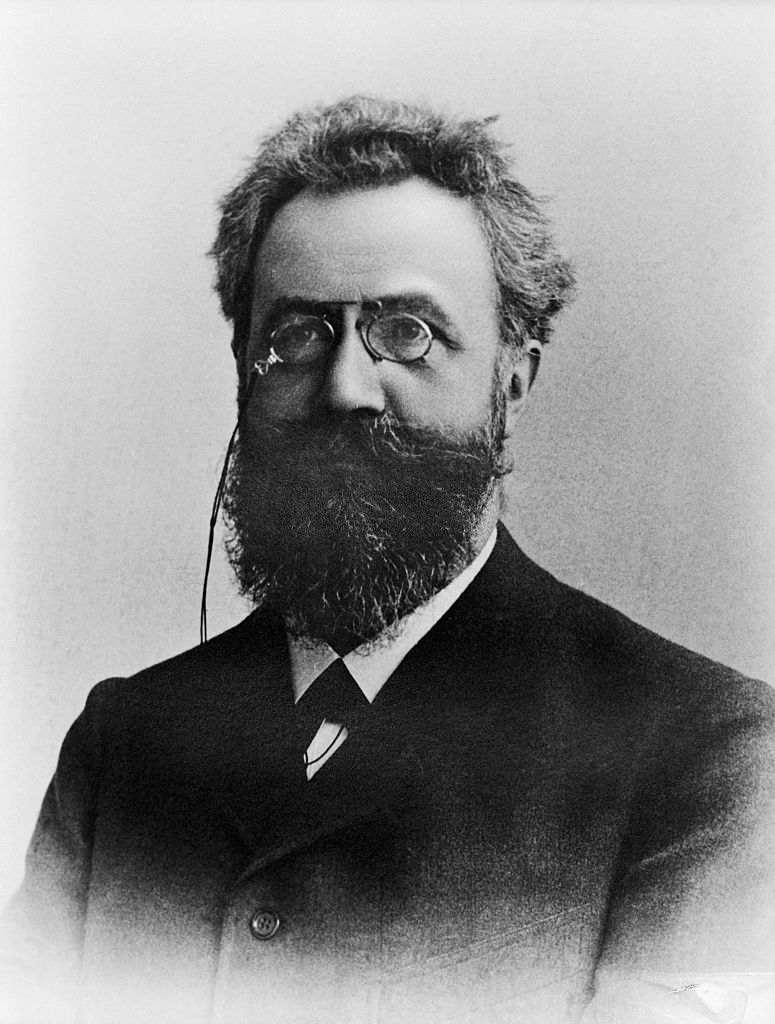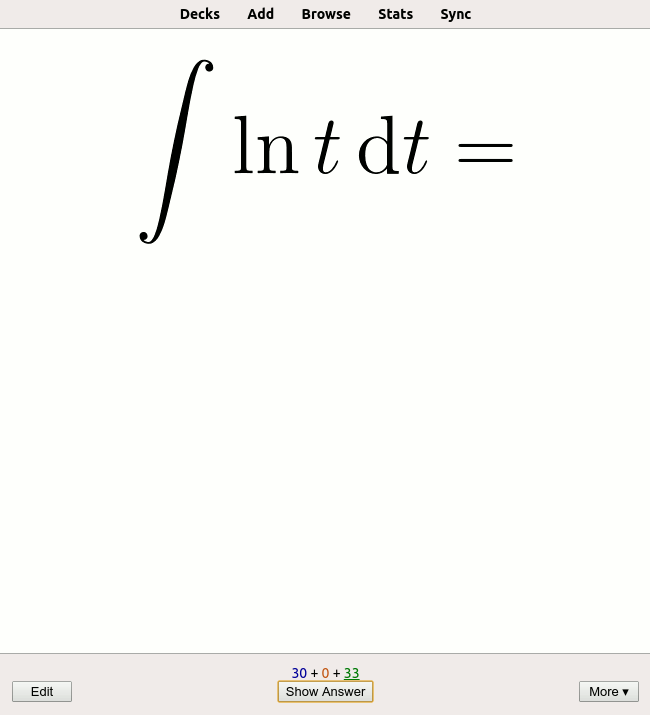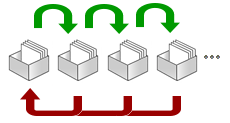|
Spacing Effect
The spacing effect demonstrates that learning is more effective when study sessions are spaced out. This effect shows that more information is encoded into long-term memory by spaced study sessions, also known as '' spaced repetition'' or ''spaced presentation'', than by massed presentation (" cramming"). The phenomenon was first identified by Hermann Ebbinghaus, and his detailed study of it was published in the 1885 book (''Memory: A Contribution to Experimental Psychology''), which suggests that active recall with increasing time intervals reduces the probability of forgetting information. This robust finding has been supported by studies of many explicit memory tasks such as free recall, recognition, cued-recall, and frequency estimation (for reviews see Crowder 1976; Greene, 1989). Researchers have offered several possible explanations of the spacing effect, and much research has been conducted that supports its impact on recall. In spite of these findings, the robust ... [...More Info...] [...Related Items...] OR: [Wikipedia] [Google] [Baidu] |
Encoding (memory)
Memory has the ability to encode, store and recall information. Memories give an organism the capability to learn and adapt from previous experiences as well as build relationships. Encoding allows a perceived item of use or interest to be converted into a construct that can be stored within the brain and recalled later from long-term memory. Working memory stores information for immediate use or manipulation which is aided through hooking onto previously archived items already present in the long-term memory of an individual. History Encoding is still relatively new and unexplored but origins of encoding date back to age old philosophers such as Aristotle and Plato. A major figure in the history of encoding is Hermann Ebbinghaus (1850–1909). Ebbinghaus was a pioneer in the field of memory research. Using himself as a subject he studied how we learn and forget information by repeating a list of nonsense syllables to the rhythm of a metronome until they were committed to his ... [...More Info...] [...Related Items...] OR: [Wikipedia] [Google] [Baidu] |
Contemporary Educational Psychology
''Contemporary Educational Psychology'' is a peer-reviewed academic journal on the topic of educational psychology. Its editor-in-chief is Patricia Alexander (University of Maryland). The journal was first published in 1976 for disseminating research and review articles relevant to educational psychology. It is considered one of the "big five" educational psychology journals (along with ''Educational Psychology Review'', ''Journal of Educational Psychology'', ''Educational Psychologist'', and ''Cognition and Instruction Cognition refers to "the mental action or process of acquiring knowledge and understanding through thought, experience, and the senses". It encompasses all aspects of intellectual functions and processes such as: perception, attention, thought, ...''). References Educational psychology journals Elsevier academic journals Publications established in 1976 {{Psychology-journal-stub ... [...More Info...] [...Related Items...] OR: [Wikipedia] [Google] [Baidu] |
Zeigarnik Effect
Named after Lithuanian-Soviet psychologist Bluma Zeigarnik, in psychology the Zeigarnik effect occurs when an activity that has been interrupted may be more readily recalled. It postulates that people remember unfinished or interrupted tasks better than completed tasks. In Gestalt psychology, the Zeigarnik effect has been used to demonstrate the general presence of Gestalt phenomena: not just appearing as perceptual effects, but also present in cognition. The Zeigarnik effect should not be confused with the Ovsiankina effect. Maria Ovsiankina, a colleague of Zeigarnik, investigated the effect of task interruption on the tendency to resume the task at the next opportunity. Overview Russian psychologist Bluma Zeigarnik first studied the phenomenon after her professor, Gestalt psychologist Kurt Lewin noticed that a waiter had better recollections of still unpaid orders. However, after the completion of the task – after everyone had paid – he was unable to remember any more det ... [...More Info...] [...Related Items...] OR: [Wikipedia] [Google] [Baidu] |
Testing Effect
The testing effect (also known as retrieval practice, active recall, practice testing, or test-enhanced learning) suggests long-term memory is increased when some of the learning period is devoted to retrieving information from memory. It is different from more general ''practice effect'', defined in the APA Dictionary of Psychology as "any change or improvement that results from practice or repetition of task items or activities." Cognitive psychologists are working with educators to look at how to take advantage of tests—not as an assessment tool, but as a teaching tools as testing prior knowledge is more beneficial for learning when compared to reading or passively studying material, even more so when the test is more challenging for memory. History Before much experimental evidence had been collected, the utility of testing was already evident to some perceptive observers including Francis Bacon who discussed it as a learning strategy as early as 1620. ''"Hence if you ... [...More Info...] [...Related Items...] OR: [Wikipedia] [Google] [Baidu] |
Memory Bias
Cognitive biases are systematic patterns of deviation from norm and/or rationality in judgment. They are often studied in psychology, sociology and behavioral economics. Although the reality of most of these biases is confirmed by reproducible research, there are often controversies about how to classify these biases or how to explain them. Several theoretical causes are known for some cognitive biases, which provides a classification of biases by their common generative mechanism (such as noisy information-processingMartin Hilbert (2012) "Toward a synthesis of cognitive biases: How noisy information processing can bias human decision making"'. Psychological Bulletin, 138(2), 211–237; free access to the study here: https://www.martinhilbert.net/toward-a-synthesis-of-cognitive-biases/). Gerd Gigerenzer has criticized the framing of cognitive biases as errors in judgment, and favors interpreting them as arising from rational deviations from logical thought. Explanations include i ... [...More Info...] [...Related Items...] OR: [Wikipedia] [Google] [Baidu] |
List Of Cognitive Biases
Cognitive biases are systematic patterns of deviation from norm and/or rationality in judgment. They are often studied in psychology, sociology and behavioral economics. Although the reality of most of these biases is confirmed by reproducible research, there are often controversies about how to classify these biases or how to explain them. Several theoretical causes are known for some cognitive biases, which provides a classification of biases by their common generative mechanism (such as noisy information-processingMartin Hilbert (2012) "Toward a synthesis of cognitive biases: How noisy information processing can bias human decision making"'. Psychological Bulletin, 138(2), 211–237; free access to the study here: https://www.martinhilbert.net/toward-a-synthesis-of-cognitive-biases/). Gerd Gigerenzer has criticized the framing of cognitive biases as errors in judgment, and favors interpreting them as arising from rational deviations from logical thought. Explanations inc ... [...More Info...] [...Related Items...] OR: [Wikipedia] [Google] [Baidu] |
Distributed Practice
Distributed practice (also known as ''spaced repetition'', ''the spacing effect'', or ''spaced practice'') is a learning strategy, where practice is broken up into a number of short sessions over a longer period of time. Humans and other animals learn items in a list more effectively when they are studied in several sessions spread out over a long period of time, rather than studied repeatedly in a short period of time, a phenomenon called the spacing effect. The opposite, ''massed practice'', consists of fewer, longer training sessions and is generally a less effective method of learning. For example, when studying for an exam, dispersing your studying more frequently over a larger period of time will result in more effective learning than intense study the night before. History Influential German psychologist Hermann Ebbinghaus first observed the effect of distributed learning, and published his findings in ''Memory: A Contribution to Experimental Psychology''. Using himself ... [...More Info...] [...Related Items...] OR: [Wikipedia] [Google] [Baidu] |
Incidental Learning
Learning is the process of acquiring new understanding, knowledge, behaviors, skills, values, attitudes, and preferences. The ability to learn is possessed by humans, animals, and some machines; there is also evidence for some kind of learning in certain plants. Some learning is immediate, induced by a single event (e.g. being burned by a hot stove), but much skill and knowledge accumulate from repeated experiences. The changes induced by learning often last a lifetime, and it is hard to distinguish learned material that seems to be "lost" from that which cannot be retrieved. Human learning starts at birth (it might even start before in terms of an embryo's need for both interaction with, and freedom within its environment within the womb.) and continues until death as a consequence of ongoing interactions between people and their environment. The nature and processes involved in learning are studied in many established fields (including educational psychology, neuropsycholog ... [...More Info...] [...Related Items...] OR: [Wikipedia] [Google] [Baidu] |
Context (language Use)
In semiotics, linguistics, sociology and anthropology, context refers to those objects or entities which surround a ''focal event'', in these disciplines typically a communicative event, of some kind. Context is "a frame that surrounds the event and provides resources for its appropriate interpretation". It is thus a relative concept, only definable with respect to some focal event within a frame, not independently of that frame. In linguistics In the 19th century, it was debated whether the most fundamental principle in language was contextuality or compositionality, and compositionality was usually preferred.Janssen, T. M. (2012) Compositionality: Its historic context', in M. Werning, W. Hinzen, & E. Machery (Eds.), The Oxford handbook of compositionality', pp. 19-46, Oxford University Press. Verbal context refers to the text or speech surrounding an expression (word, sentence, or speech act). Verbal context influences the way an expression is understood; hence the norm of n ... [...More Info...] [...Related Items...] OR: [Wikipedia] [Google] [Baidu] |
Stimulus (physiology)
In physiology, a stimulus is a detectable change in the physical or chemical structure of an organism's internal or external Environment (systems), environment. The ability of an organism or Organ (anatomy), organ to detect external stimuli, so that an appropriate reaction can be made, is called sensitivity (excitability). Sensory receptors can receive information from outside the body, as in touch receptors found in the skin or light receptors in the eye, as well as from inside the body, as in chemoreceptors and mechanoreceptors. When a stimulus is detected by a sensory receptor, it can elicit a Reflex action, reflex via Transduction (physiology), stimulus transduction. An Internal stimuli, internal stimulus is often the first component of a Homeostasis, homeostatic control system. External stimuli are capable of producing systemic responses throughout the body, as in the fight-or-flight response. In order for a stimulus to be detected with high probability, its level of strengt ... [...More Info...] [...Related Items...] OR: [Wikipedia] [Google] [Baidu] |
Semantic Priming
Priming is a phenomenon whereby exposure to one stimulus influences a response to a subsequent stimulus, without conscious guidance or intention. The priming effect refers to the positive or negative effect of a rapidly presented stimulus (priming stimulus) on the processing of a second stimulus (target stimulus) that appears shortly after. Generally speaking, the generation of priming effect depends on the existence of some positive or negative relationship between priming and target stimuli. For example, the word ''nurse'' is recognized more quickly following the word ''doctor'' than following the word ''bread''. Priming can be perceptual, associative, repetitive, positive, negative, affective, semantic, or conceptual. Priming effects involve word recognition, semantic processing, attention, unconscious processing, and many other issues, and are related to differences in various writing systems. Research, however, has yet to firmly establish the duration of priming effects, yet ... [...More Info...] [...Related Items...] OR: [Wikipedia] [Google] [Baidu] |



